Hamish Lindsay writes:
The Goddard Space Flight Center in Maryland, our
technical and engineering managers, published a regular newsletter called
Goddard News, and the copy following the Apollo 8 mission was full of
the success of the mission, and featured the three 26 metre stations in a
full-page centre spread.
The Goddard Public Affairs Office sent their representative,
Don Witten, to Honeysuckle Creek to cover the mission, and he did us
proud, giving us a bigger coverage than Goldstone.
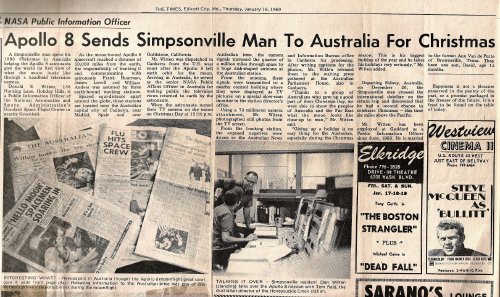 |
Here’s a story about Don’s trip to Australia, in ‘The Times’ newspaper, Elliot City, Maryland, January 16 1969.
Scan: Don Witten.
|
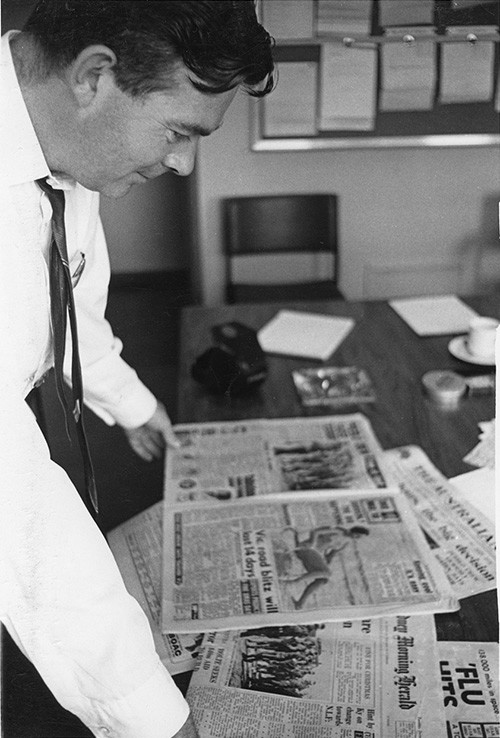 |
And here’s Deputy Station Director Mike Dinn in the Station Director’s office, looking at the newspapers in the story above, 24 December 1968.
Photo via Mike Dinn, scan: Colin Mackellar.
|
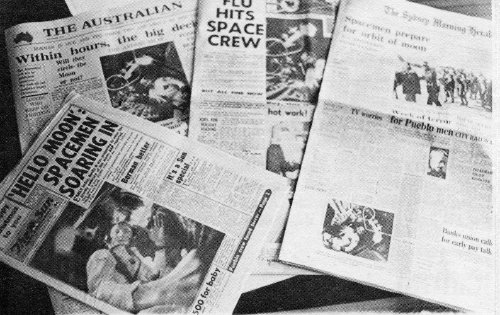 |
Here is a photo of the newspapers in Goddard News.
Scan: Colin Mackellar.
|
Don Witten arrived with cameras
and three cartons of film, mostly the then new 70mm cassette format, which
exposed 50 frames per roll.
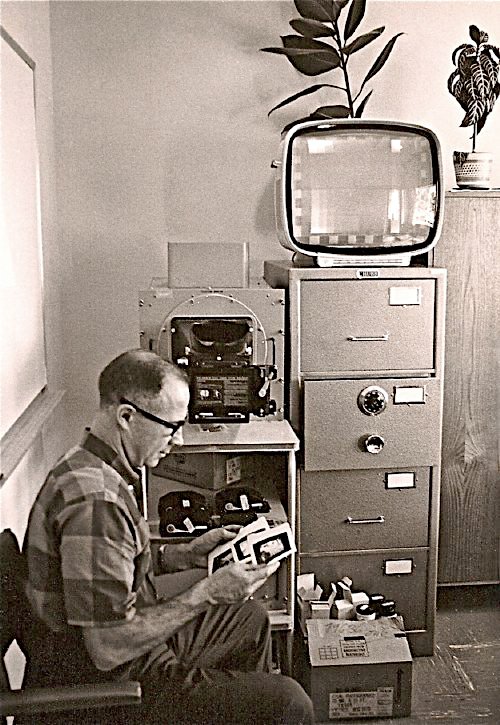 |
Don Witten examines some of the Polaroid photos he took of Apollo 8 slow scan TV showing the scene from lunar orbit.
He is sitting in Station Director Tom Reid’s office at Honeysuckle Creek. The Fairchild slow scan monitor, with the camera mounted, is to the left of the filing cabinet. The 70mm cassettes are on the shelf below the monitor.
Photo: Don Witten. Image restoration: Colin Mackellar.
|
Like any good American he found
a pretty girl, (Jenny Hame, top) photographed her in front of the
antenna, and used the photo to head the article about us.
The article gives an idea
of the atmosphere of the time:
“The quiet and proper look of the main floor of the
majestic Parliament House [the old one] in the Australian capital city of
Canberra literally belied the buzzing informality of the second floor
press room on Christmas Day, 1968. For representatives of the Australian press
– wire services, newspapers, television, and radio alike – were
there waiting for the first man-made photos of the Moon to be received in
Australia.
As the reporters were handed the photographs, they asked
their final questions of Willson Hunter, NASA’s Senior Scientific Representative
in Australia, and broke for the door in a run. Within the hour, the photos
began appearing on Australian television. By the next day they had found their
way into every newspaper across the continent.
Australia shared in the reception of these historic photos
because it hosts one of the three prime tracking stations designed to support
the Apollo missions.
Working around the clock, the Manned Space Flight Network
Station at Honeysuckle Creek and its Wing unit, the Deep Space Network Station
at nearby Tidbinbilla, tracked the Apollo-8 for about one third of its flight.
Honeysuckle Creek station director is Tom Reid and Don Gray is director of
the unit at Tidbinbilla
Responsibility for the operation of these two stations,
both of which are located about an hour’s drive from Canberra, is vested
in the Australian Department of Supply on behalf of NASA. M. Ian Homewood,
Assistant Secretary (Projects) for the DOS manages this joint effort on behalf
of Australia.
As the TV signals from the Apollo-8 were received by
the two Australian stations, a picture was displayed on a slow-scan television
monitor in Tom Reid’s office. Still photos were recorded from the screen
with a special 70mm camera unit, attached to the monitor.
From the Honeysuckle Creek station, the exposed negatives
were sped by car to the Australian News and Information Bureau for processing
and ultimate delivery along with on-the-spot captions to the Parliament press
room and waiting reporters.
Some of the key people at the Honeysuckle station assisting
Tom Reid were Mike Dinn, deputy station director and operations assistants
John Saxon and Ken Lee. Ian Grant, a new deputy station director was observing
this mission. Bernard Scrivener, also new at the Honeysuckle station as an
administrative officer, assisted Reid and acted as spokesman for
the station.”
So that was how our temporary American publicity officer
saw the mission.
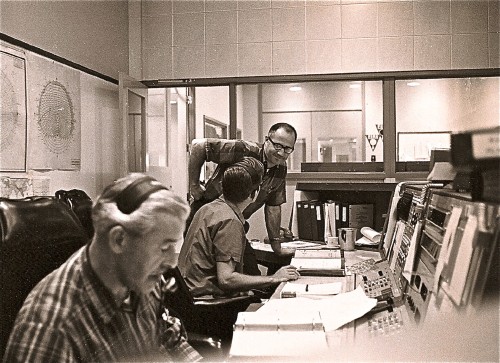 |
Don Witten speaks with Station Director Tom Reid, who is seated at the Honeysuckle Creek Operations Console.
Operations Supervisor Ken Lee is in the foreground.
Photo: Don Witten, taken using a self-timer.
Image restoration: Colin Mackellar.
|
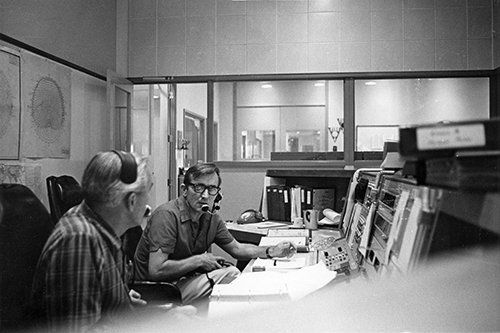 |
Station Director Tom Reid and Operations Supervisor Ken Lee (foreground) seated at the Honeysuckle Creek Operations Console.
Photo by Don Witten.
Photo preserved by Hamish Lindsay. Scan by Colin Mackellar.
|
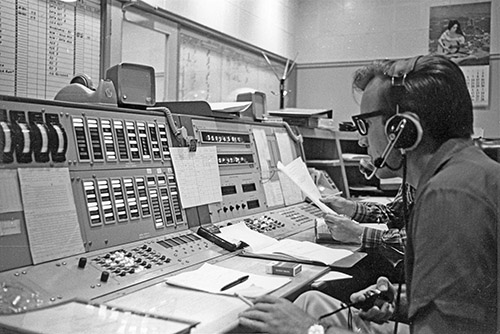 |
Don Witten took this photo of Station Director Tom Reid at the Operations Console during Apollo 8. Ops Supervisor Ken Lee is partially visible.
The time display reveals this photo was taken on Day of Year 359, December 24, 1968 at 16:58 UTC – i.e. Christmas Day, Wednesday December 25, at 2:58am Australian Eastern Standard Time.
Photo by Don Witten. Preserved by Hamish Lindsay.
Scan and ID by Colin Mackellar.
|
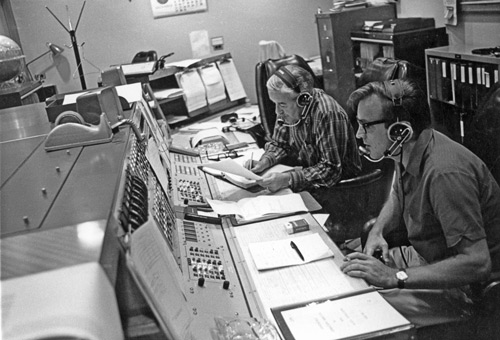 |
This photo, taken at the same time, gives a slightly different view of the Operations Console.
Photo by Don Witten. Preserved by Hamish Lindsay.
Scan and image processing by Colin Mackellar.
|
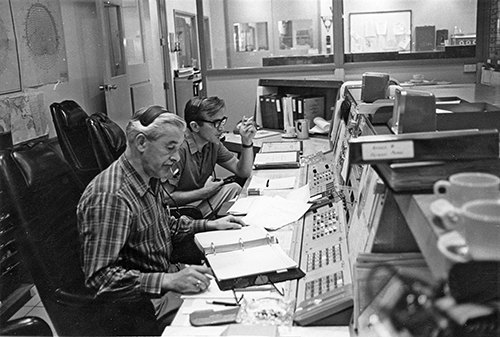 |
Station Director Tom Reid and Operations Supervisor Ken Lee (foreground) seated at the Honeysuckle Creek Operations Console.
Photo by Don Witten, and used in Goddard News (see below).
Photo preserved by Hamish Lindsay. Scan by Colin Mackellar.
|
Under Station Director Danny Hunter (who was the
leader of the flight control team for Gemini III at Carnarvon) the Madrid story at Fresnedillas and Robledo was similar, they received the first pictures
from the Moon at 1326 local time on 24 December 1968, which were sent by coax
cable to London where the BBC, representing Eurovision and Mundovision, distributed
them with all the different languages. The commercial television pictures
were captioned with “Live from Apollo 8 – Madrid Tracking Station.”
Still photos of the TV transmission were released to
a world wide wire photo pool headed by the Associated Press and United Press
International shortly after the telecast was concluded. A wire photo scanner
at the tracking station, connected by four thin telephone lines transmitted
the dramatic pictures of lunar craters to every news service and daily newspaper
in the world – at once. The entire global wire photo net was set up for
the historic transmission.
Goldstone in the Mojave Desert was the Prime site for this mission. Under
Station Director George Fariss, they too, were waiting for the first
ever photographs of the lunar surface taken by humans. A system of microwave
links flashed the live television to the world. They also used a 70mm system
off the slow scanner for still photographs, the films flown to Los Angeles
where the NASA Still Photo Pool developed and printed them. Selected frames
were then released to the national wire services and magazines.
Honeysuckle Creek was featured on the back page, with
pictures of our newspaper headlines, Ken Lee and Tom Reid at
the ops console, Bernard Scrivener, and the slow scan photographing
set up.
– Hamish Lindsay
Here is the coverage of the three 85 foot MSFN stations during Apollo 8 in Goddard News
|
The spread on pages 7 & 8 of Goddard News for January 13, 1969.
Madrid, left column; Goldstone, centre; Honeysuckle Creek, right.
Preserved by Mike Dinn, scanned by Colin Mackellar.
|
|
Page 8 of Goddard News for January 13, 1969.
Madrid and Honeysuckle Creek.
Preserved by Mike Dinn, scanned by Colin Mackellar.
|
|
Goddard News, Volume 16, No. 10, January 13, 1969.
10 page PDF file.(8.5MB)
Preserved by Mike Dinn, scanned by Colin Mackellar.
|
Higher resolution scans of all these pages are available on request.
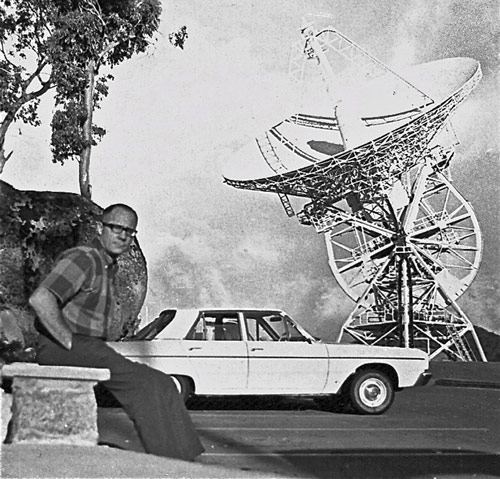 |
Don Witten seated at the edge of the car park, opposite the Operations Building.
Photo: Don Wittten.
|









